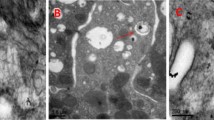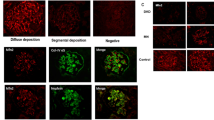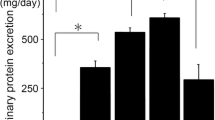Abstract
Purpose
The aim of this study was to investigate the number of autophagosomes in podocyte from kidney tissue of immunoglobulin A nephropathy (IgAN) and idiopathic membranous nephropathy (IMN).
Methods
The changes in kidney tissue pathology were detected after hematoxylin and eosin, periodic acid-Schiff, Masson’s trichrome and immunofluorescence. The autophagosomes of podocyte were analyzed by transmission electron microscopy. Clinical data, including age, gender, edema, serum creatinine, estimated glomerular filtrating rate (eGFR), hematuria, urine protein excretion and serum albumin, were collected from inpatient medical record.
Results
It was found that the number of autophagosomes in podocyte of nephropathy group was lower when compared to the control group. At the same time, we did not find the difference of the parameter between these two kinds of nephropathy. Further study showed that the index was affected by two factors: eGFR and gender. The cases with worse eGFR (eGFR < 60 ml/min) and male patients presented more autophagosomes. Furthermore, each nephropathy had its own character. The phenomena of reduced autophagosomes were found in IMN cases, did not change from male to female, and further aggravated from pathological stage I to II. By contrast, IgAN cases with less eGFR exhibited more autophagosomes.
Conclusions
Therefore, the results of the present study indicate that autophagy participates in podocyte injury and the progression of IgAN and IMN.


Similar content being viewed by others
References
Martinez J, Cunha LD, Park S et al (2016) Noncanonical autophagy inhibits the autoinflammatory, lupus-like response to dying cells. Nature 533(7601):115–119
Mizushima N, Komatsu M (2011) Autophagy: renovation of cells and tissues. Cell 147:728–741
Wyatt RJ, Julian BA (2013) IgA nephropathy. N Engl J Med 368:2402–2414
Floege J, Moura IC, Daha MR (2014) New insights into the pathogenesis of IgA nephropathy. Semin Immunopathol 36:431–442
Kiryluk K, Novak J (2014) The genetics and immunobiology of IgA nephropathy. J Clin Invest 124:2325–2332
Radice A, Trezzi B, Maggiore U et al (2016) Clinical usefulness of autoantibodies to M-type phospholipase A2 receptor (PLA2R) for monitoring disease activity in idiopathic membranous nephropathy (IMN). Autoimmun Rev 15:146–154
Tang L, Yao J, Kong X et al (2016) Increasing prevalence of membranous nephropathy in patients with primary glomerular diseases: a cross-sectional study in China. Nephrology. doi:10.1111/nep.12739
Rohit T, Ritambhra N, Charan SR et al (2015) Correlation of proteinuria with podocyte foot process effacement in iga nephropathy: an ultrastructural study. Ultrastruct Pathol 39:147–151
Shen P, Shen J, Li W et al (2014) Urinary podocyte can be an indicator for the pathogenetic condition of patients with IgA nephropathy. Clin Lab 60:1709–1715
Beck LH, Bonegio RGB, Lambeau G et al (2009) M-type phospholipase A2 receptor as target antigen in idiopathic membranous nephropathy. N Engl J Med 361:11–21
Sinico RA, Mezzina N, Trezzi B et al (2015) Immunology of membranous nephropathy: from animal models to humans. Clin Exp Immunol 183:157–165
Polanco N, Gutierrez E, Covarsı A et al (2010) Spontaneous remission of nephrotic syndrome in idiopathic membranous nephropathy. J Am Soc Nephrol 21:697–704
Björn H, Markus G, Catherine MS et al (2010) Autophagy influences glomerular disease susceptibility and maintains podocyte homeostasis in aging mice. J Clin Invest 120:1084–1096
Pavlisko EN, Howell DN (2013) The continued vital role of electron microscopy in the diagnosis of renal disease/dysfunction. Ultrastruct Pathol 37:1–8
Mizushima N, Levine B, Cuervo AM et al (2008) Autophagy fights disease through vellular self-digestion. Nature 451:1069–1075
Mizushima N, Yamamoto A, Matsui M et al (2004) In vivo analysis of autophagy in response to nutrient starvation using transgenic mice expressing a fluorescent autophagosome marker. Mol Biol Cell 15:1101–1111
Caihong Z, Yun F, Junnan W et al (2014) Podocyte autophagic activity plays a protective role in renal injury and delays the progression of podocytopathies. J Pathol 234:203–213
Rosanna C, Stephan T, Shubha B et al (2014) Validation of the Oxford classification of IgA nephropathy in cohorts with different presentations and treatments. Kidney Int 86:828–836
Liyuan W, Quan H, Yang L et al (2012) Autophagy can repair endoplasmic reticulum stress damage of the passive Heymann nephritis model as revealed by proteomics analysis. J Proteomics 75:3866–3876
Qianying L, Fengjie Y, Kun CH et al (2016) Autophagy protects podocytes from sublytic complement induced injury. Exp Cell Res 341:132–138
Tagawa A, Yasuda M, Kume S et al (2016) Impaired podocyte autophagy exacerbates proteinuria in diabetic nephropathy. Diabetes 65:755–767
Tangli X, Xu G, Ling N et al (2014) Rapamycin promotes podocyte autophagy and ameliorates renal injury in diabetic mice. Mol Cell Biochem 394:145–154
Acknowledgments
This study was funded by the General Project of the Medical and Health of Zhejiang Province (Grant Number 2014kYA014), the Project of Scientific research Foundation of Chinese Medicine (Grant Number 2014ZB002), the Project of Clinical and Scientific research Foundation of Medical associate of Zhejiang Province (Grant Number 2013ZYC-A01), the General Project of the Medical and Health of Zhejiang Province (Grant Number 2015KYA025), the Project of Scientific research Foundation of Chinese Medicine (Grant Number 2015ZA011) and Zhejiang Provincial Program for the Cultivation of High-level New Health Talent (Grant Number 2013).
Author information
Authors and Affiliations
Corresponding author
Ethics declarations
Conflict of interest
The authors declare that they have no conflict of interest.
Ethical approval
All procedures performed in studies involving human participants were in accordance with the ethical standards of the institutional and national research committee and with the 1964 Helsinki Declaration and its later amendments or comparable ethical standards.
Informed consent
Informed consent was obtained from all individual participants included in the study.
Rights and permissions
About this article
Cite this article
Liang, S., Jin, J., Gong, J. et al. How many podocyte autophagosomes are there in immunoglobulin A nephropathy and idiopathic membranous nephropathy?. Int Urol Nephrol 48, 2109–2114 (2016). https://doi.org/10.1007/s11255-016-1398-5
Received:
Accepted:
Published:
Issue Date:
DOI: https://doi.org/10.1007/s11255-016-1398-5




